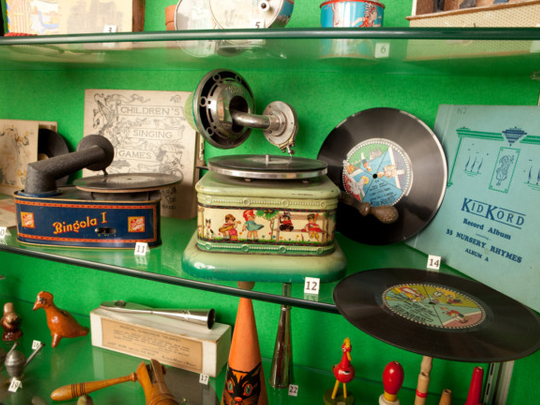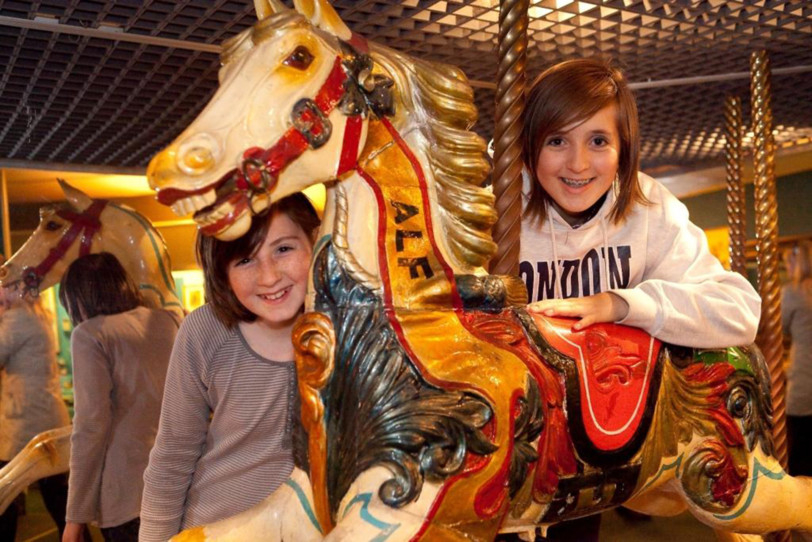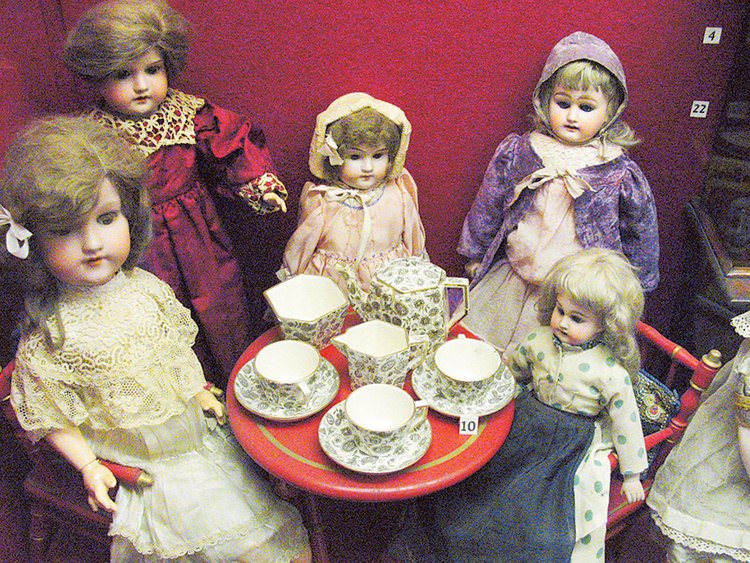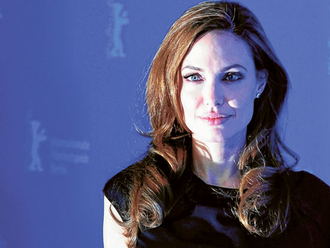
The Museum of Childhood is one of Edinburgh’s most cherished, situated on the Royal Mile and popular for its collections of porcelain dolls, puppets and pushbikes. It has a collection of some of history’s greatest toys and other objects related to childhood, but is open for all ages. The brainchild of Edinburgh town councillor and toy collector Patrick Murray, the museum covers all aspects of childhood, from the 18th through to the 21st centuries.
This was apparently the first museum in the world to specialise in the history of childhood, and is packed with toy relics and more recent toy memorabilia. There is also some history on the way children have been brought up, and dressed over the years. This unique museum has free entry and offers something for everyone — from a chimney sweep’s work clothes from Victorian times to modern classics such as Meccano and roller skates.
The museum doesn’t look very grand from the outside, but inside, six floors of glass cases are crammed with toys and books.
At present, the museum is on its way to a major revamp and transformation after 30 years as its ground floor is completely remodelled into a modern fun factory for children. This year a new gallery showcasing newer toys and technology will open.
“My favourite toy on display is the early soft toy of Peter Rabbit, a book character by Beatrix Potter and one of her books. Potter’s books date back to 1902 and this toy a few years after that. She had the brilliant idea of producing books that were small so that children could carry them around easily and that they wouldn’t be too expensive. She also very quickly realised that if you produced toys of the book characters, children would want to buy them,” says Lyn Wall, the museum’s curator.
Changing traditions
Once upon a time, not long ago, childhood was far more carefree time than it is today, free from the pressures the children and parents now feel in the times of digital technology. Few kids play with dolls or Play-Doh alone. They are used to so much more than just traditional toys. Exhibits such as the old boot fashioned into a doll from the 1800s are a gentle reminder of how circumstances have changed.
Childhood experiences are always changing, just as adult experiences constantly change with new fashions and technology. “Children still play with some traditional toys such as dolls, bikes and construction bricks, but they now have more choices. Just as children in the second half of the 20th century had the new choice of watching television, now children have another choice of electronic games. Minecraft is really just a new version of Lego, it stills takes imagination and creativity to build landscapes, but on a screen instead of on the floor,” says Wall.
She says that the museum aims to represent today’s childhood as well as experiences of the past. “As a curator, the most rewarding part of the job for me is that I am constantly learning new information about the history of childhood and our collections, and I get to share that information with our visitors through exhibitions and talks, and for future generations through documenting and recording.”
There’s no shortage of research indicating the benefits of museum visits for children. Museums provide memorable, immersive learning experiences, provoke imagination, introduce unknown worlds and subject matter, and offer unique environments for quality time with family.
The process of how the renovation plans are coming along is interesting. “Depending on the size of a new gallery or exhibition, it can take one or two years in planning. To decide upon a theme we may consult visitors, or it may be the outcome of a research project, we may wish to highlight new collections or a festival or event we can link it to. We have to research our collections to find relevant objects to tell the stories and sometimes collect new objects. Objects may need to be cleaned or conserved, mounts for objects made, labels written and images found. Activities around new displays will also be planned, such as events people can come to, or worksheets for school groups, etc,” Wall says.
Toy collection
The collection was originally the work of Murray (1908-1981), a passionate collector of toys and childhood memorabilia. Murray started the collection in 1955 and additions are constantly made to it. “We are very lucky to receive lots of donations from the people of Britain and from overseas sometimes,” says Wall. The collection totals about 60,000 objects and is still growing. “At the moment we are particularly collecting items from the 1980s for a future exhibition, and we wish to collect from the last 20 years to update the collection. We collect toys, games, books, social history, clothes and educational items.”
The recent national funding to revive the sector was covered in arts news across the continent. The museum staff is very excited to have the opportunity to display collections in innovative ways. “After being selected as one of two museums in Edinburgh to receive a grant of £95,584 [Dh431,052] from Museums Galleries Scotland [the national development authority for the museum sector in Scotland], the museum plans to make the main floor gallery more interactive for families are being drawn up,” reported “Edinburgh News” last February.
In the near future, visitors can expect to see display collections in new cabinets, as well as a fresh space aimed at encouraging integrated play and active learning. “The museum is constantly exploring ways in which they can make the space more welcoming and how they can encourage a playful approach, from imaginative use of lighting, photographs and film to develop interactive exhibits — both low and hi-tech,” says Wall.
Since the museum opened in 1955, it has collected a wide variety of toys, games, clothes and books. It has a large collection of rocking horses, old-fashioned bikes and even children’s shoes over the ages. The museum aims to explore all aspects of childhood, including topics such as parenting, sanitation, healthcare and education. However, with the extra funding, the museum is now busy introducing new displays and bringing out stored items that have been waiting their turn for more than 30 years.
The museum is split into five galleries over several floors. The ground floor gallery has pedal cars and exhibits of toys — some dressed in Victorian work clothes. Here you will find the Pianola, a piano from the 19th century that plays a tune if you put a coin in the slot.
Puppets and miniatures can be found upstairs in Gallery 2. There’s a good selection of puppets on display as well as a small puppet theatre that children or visitors can actually use. This gallery also has a miniature shop and a variety of enormous dollhouses on display. Then there’s also the large O Gauge model railway with a variety of model trains, as well as a range of toy model cars and aeroplanes. The gallery also has two miniature zoos and a circus scene. At one end of this floor there is a section with a display of home movies and film equipment, reflecting how parents captured their young ones’ childhood through the years. It also shows how children use video equipment as part of their day-to-day educational requirement. There are also some films to watch here — some old family home-movies, and some made as museum projects by children.
Dolls and teddy bears of every kind can be found in Gallery 3. It has perhaps the largest collection of dolls you’ve ever seen. Most are beautiful — though there are a few strikingly plain examples, too. There is a small number of Golliwogs that appeared in storybooks in late 19th century. They are controversial since critics tagged its creators of racist disposition. Near this display you will find a notice that explains why these have not been struck from the historical record, and offers contact details if you feel the need to comment or complain. Amusingly, less politically incorrect is the Teddy Bear’s Picnic display — where one can spot a variety of bears from different ages enjoying their day out in the woods.
Gallery 4 focuses on games, construction toys and a display of books, including early editions of Potter’s classic children’s tales such as the Peter Rabbit. Look out for the Big Wheel made from thousands of Meccano sets.
Gallery 5 on the fifth floor has some dioramas that look like movie sets. They include a school’s class room replica, a Victorian street scene as well as a nursery complete with rocking horse. There’s also a small dressing up area, quite popular with kids, where they can transform themselves into children from bygone eras.
Bedtime Stories
The museum also holds temporary exhibitions. “We currently have a new temporary exhibition called ‘Bedtime Stories’ and we are working on creating a new ground floor gallery. This new gallery will allow us to display objects that have not yet been on display and explore some new topics,” says Wall.
When the museum does not have a key item for a display, it sometimes borrows objects from other museums. The museum also lends their collections to other museums for their displays. “Usually you would ask for a loan six months in advance,” says Wall.
Public support
Alongside curators at the Museum of Childhood there is a conservator and a technician who help with exhibitions. The museum also has a team of volunteers who help with documentation. A collections engagement officer, an outreach and access manager, a learning and public programmes manager and a team of visitor services staff all work to help people interact with the collections both in the museum and out in the community.
Visitors can contribute to the museum by letting the museum know what they like and don’t like and suggesting ideas for future displays. They can also participate in events and activities here.
Sometimes it is not easy to preserve old and used toys. “We have a conservator who works on our collections as required and as part of the curatorial job we ensure objects are packed in acid-free materials and kept clean,” says Wall.
The museum is quite traditional — mainly displaying artefacts in glass cases, rather than a modern interactive style museum. Over the years, only a few children’s toys were targeted specifically at boys or girls and a large majority of the popular toys now have no gender-specific labels.
Visitors to the museum may notice that boys and girls have always been given different toys in the past, and that gender differences were probably more marked then. It was almost advertising and proclaiming that a model railway is the perfect activity for boys and their fathers — a statement which would probably not be acceptable in the 21st century.
Museums for Children
Lifelong learning begins at a young age and museums are a great place to spark an interest in history, art and science. Museums provide an effective opportunity to show children various experiences and encourage them to explore new things in a rich and educational environment. Through interactive exhibits and hands-on play, children take ownership of their own learning and develop and explore their own curiosities. This genre of exposure provides the foundation for creativity, critical thinking, and connection to the world around them.
While adult visitors get a glimpse of different times and places, for a child it offers a broader understanding of the past. This kind of exposure can help develop higher critical and creative thinking skills, which are integral to future success.
All educational activities and resources at the Museum of Childhood are designed to encourage discussion, and as per the staff, they aim at “transforming galleries into laboratories of ideas”.
The Museum of Childhood offers a profound reflection on the nature of childhood, though it can be debated that a deeper perspective depends on the kind of individual who visits this venue. It is a display of both historical novelty and recent nostalgia.
Though there are few Asian toys here, the museum is almost solely Western focused. It offers an interesting comparison of not only different time, but in a different space. It may intrigue the onlooker of contemporary children and of childhood of the past. It gives hope that children need not solely be mindless occupiers of a digital world.
The museum shop sells traditional objects of entertainment for young minds, such as Diablo, the action role-playing video game, to simpler toys like yo-yos. The shop stocks a wide selection of nostalgic and humorous postcards. A remarkable window display has three cheeky toy monkeys with a note beside them saying that they were the stars of the story book “The Royal Mile at Midnight” — a delightful little story of the toy family that lives at the Museum of Childhood. The book, written by Richard Paterson and illustrated by Gertrude Matheson, is proof that not all children’s books are for children alone, nor all museums in this category.
Archana R.D. aka B’lu is an artist-journalist based in the UAE who writes on global art and culture.














